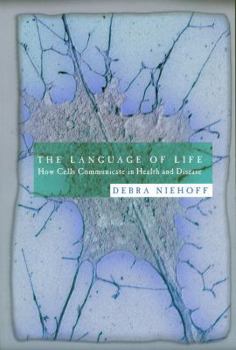The Language of Life: How Cells Communicate in Health and Disease
Select Format
Select Condition 
Book Overview
Cooperation requires conversation. Human beings speak to one another. Sounds, scents, and postures allow animals to make their point. While individual cells can't talk, hiss, growl, or bare their teeth, they nevertheless communicate regularly. Their language is based not on words or gestures, but on chemistry ?using molecules where we would use words, constructing sentences from chains of proteins. The cells that make up the bodies of muticellular...
Format:Paperback
Language:English
ISBN:0309102014
ISBN13:9780309102018
Release Date:April 2005
Publisher:Joseph Henry Press
Length:336 Pages
Weight:1.20 lbs.
Dimensions:0.8" x 6.0" x 9.0"
Customer Reviews
5 ratings
Real Science, for Non-Scientists
Published by Thriftbooks.com User , 18 years ago
My four-star rating is for the content, not the style. Other reviews have called it "dumbed down" because of superfluous anecdotes, useless analogies, and passages that sound as if they're aimed at grade-school children. There is something to that, but there is also a lot of real science here. The effect is rather disconcerting, a bit like "Oh, Dick, see the kinase phosphorylate the tyrosine." (Don't worry; the terms are defined in the text.) But, all in all, it is worth reading. The review which says that the book looks at the workings of the human body is most accurate. There is some material on signaling between bacteria, but the book is mostly about us humans. This is too bad for me, because I have a strong interest in evolutionary biology and more comparison across the spectrum of life would have been welcome. But many readers will be interested primarily in the material presented here. I found the fifth chapter, which covers the brain and the immune system, to have too much analogy and not enough biochemistry for me. But it may be informative for a reader who has less knowledge of molecular biology than I do. (If you'd like some perspective on my background, click on my name at the head of this review.) To sum up: for non-scientists, this is a good introduction to a subject of considerable interest, and it covers a wide range. If you want to know more about any particular topic, it gives you the terms you need to surf the web. I expect to do a lot of that.
A complex and beautiful tongue made easily understandable
Published by Thriftbooks.com User , 18 years ago
I'd like to think I'm a pretty smart guy, but science books often leave me cold. However, wanting to learn something about how we are built and why things work the way they do,or don't, I chose this book hoping to be enlightened...and I was. I was especially drawn in by the almost poetic style, where Niehoff's tales, relating the mysteries of cell biology and the development of our minds and bodies to everyday events in her family life, made me easily able to understand complex science in a way that allowed me to feel like an expert, and know myself, far better than I did before I read this very unique book I heartily recommend Niehoff's book to the inquisitive reader, seeking a means to understand the basic biology of our bodies and selves. It is delivered in a style agreeable and accessible to a generalist like me, who reads passionately in many fields of interest. Judging from the complexity and depth of material covered I am guessing scientists of all types might find this enlightening, as well Given the superficiality of so much media today it is truly refreshing to find issues of such depth covered in such an easily accessible way. I suggest that you buy this book, and learn about yourself, and the body and mind you live in.
A truly fascinating tour of the hidden secrets of the human body
Published by Thriftbooks.com User , 18 years ago
Neurobiologist Debra Niehoff presents The Language Of Life: How Cells Communicate In Health And Disease, an amazing scrutiny of how individual cells communicate with chemical signals, and achieve tasks ranging from recording human memory to healing bodily injury. Though The Language Of Life does not shy from medical terminology, it does attempt to present advanced biological concepts with sufficient explanation to invite curious lay readers along for the ride. A truly fascinating tour of the hidden secrets of the human body.
Cell-cell signaling simplified
Published by Thriftbooks.com User , 18 years ago
Debra Niehoff does an incredible job at simplifying the complexity of cell-cell signaling and condensing thousands of research papers into an exciting book. Communication among cells is an important area of science that includes such diverse fields as embryology, oncology, pharmacology, neuroscience, endocrinology, microbiology, and many others. However, most scientists rarely consider the similarities in the signaling pathways between bacteria and humans, or among different systems in humans. By providing an overview of cell-cell signaling in diverse systems, Dr. Niehoff gives a unique perspective that will be educational even to those in the field, although the primary target is scientists in other fields and non-scientists. The relevance of cell-cell signaling to many diseases, including diabetes and cancer, makes this compelling reading for non-scientists. Dr. Niehoff's writing style, filled with wit and anecdotes, makes a difficult subject easy to comprehend. Her comparisons between cell-cell signaling and human social interactions provide a simple way to understand the cell biology, and the occasional use of humor keeps the subject interesting. Overall, this is one of the best books I have read in the area of neuroscience/cell biology that is written for non-scientists (or scientist in other fields, or young scientists-to-be).
EXCELLENT !!!
Published by Thriftbooks.com User , 18 years ago
THERE ARE NO WORDS TO DESCRIBE IT. LET YOUR CELLS TELL YOU THE STORY.




